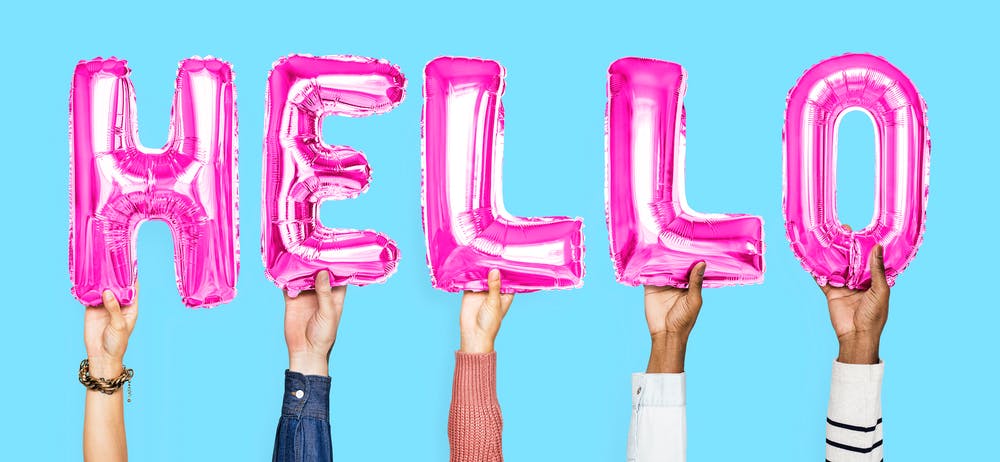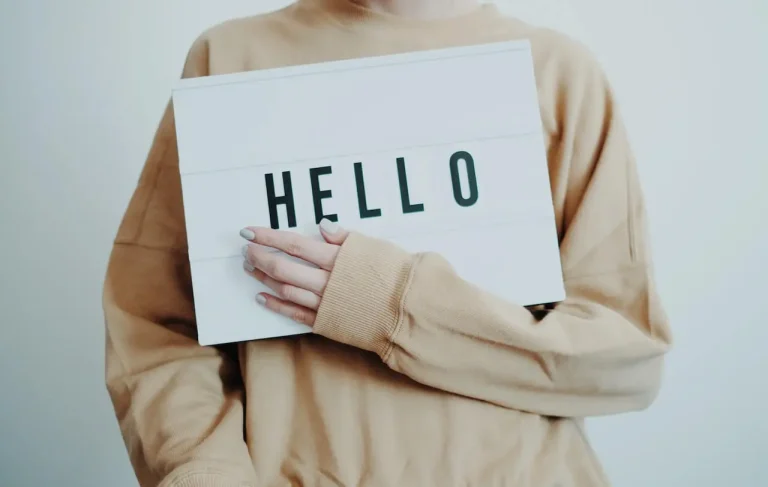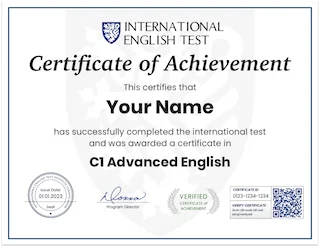Learn 50+ expert English greetings for every day with native speakers.
Hi, Bonjour, Hola, Salaam, Guten tag, Hello, Здравстуйте!
It’s the initial word you grasp in any new language, the fundamental expression of welcome indicating your intention to engage in a conversation. You likely learned the basic English greetings before delving into language learning. Yet, for a more vibrant and impactful first impression, there are numerous colorful ways to say “hello.”
Want to discover the most professional greeting for a video call with colleagues? Seeking slang terms for texting your younger cousin? Or perhaps a distinctly British-English “hello” to amuse the bus driver on your upcoming trip to London? This comprehensive list will walk you through various words and phrases, allowing you to confidently greet anyone in English.
What is your English level?
Find out your A1 A2 B1 B2 C1 C2 level of English with our online test and receive your English certificate.
Formal greetings
There are instances where employing a more formal or business-oriented language is essential to maintain a professional demeanor. The following are the most frequent situations that call for such greetings:
- showing respect to an older person
- communicating with top management or CEO
- chatting with a new colleague
- speaking with someone you barely know
- job interview
- business meeting
- having a conversation with clients
Use the following salutations to start a formal conversation in any of these situations.
1.How do you do?
If you seek an exceedingly formal expression for a first encounter or require business English vocabulary in a professional setting, the following phrase is highly suitable. Although this salutation is less common in contemporary usage, it may still be encountered, particularly from older individuals.
“Hello. How do you do?” is ideal for occasions like a business dinner or a formal event such as a conference. In alignment with professional etiquette in any language, an appropriate response would be a neutral or positive acknowledgment such as “I’m doing well, thank you” or “Fine, thank you.” This helps maintain a certain level of formality, even if your actual mood may not be particularly positive.
2. Nice to meet you / Pleased to meet you
This is one of the respectful greeting examples you can use replying to someone you meet for the very first time. For example:
- A: Good morning. I’m Alex White from [Company].
- B: Nice to meet you, Mr. White.
3. How have you been?
This is a polite way to ask “How are you?” when you have not seen a person for a long time. Ask this question only if you have met someone before.
- A: How have you been?
- B: I’ve been busy working a lot. How about you?
4. Good Morning / Good Afternoon / Good Evening
These methods of greeting individuals are employed during specific periods of the day. Whether engaging with a familiar customer, coworkers, or new neighbors, these expressions prove effective in initiating conversations.
The choice of greetings varies according to the time of day. For instance, “Good morning” is typically used from 5:00 a.m. to 12:00 p.m., while “Good afternoon” is appropriate from 12:00 p.m. to 6:00 p.m. “Good evening” is commonly used after 6 p.m. or when the sun sets.
Keep in mind that “Goodnight” is not a salutation. In formal communication, it is used to say goodbye. For example:
- It was nice to meet you. Goodnight!
- Goodnight! See you tomorrow.
As a gesture of respect, you may include the individual’s last name in your greeting. Typically, native English speakers, even in professional communication, often opt for a more informal approach and use the person’s first name following the salutation:
- Good morning, Mr. Houston
- Good afternoon, Ms. Partridge
- Good morning, Tom
- Good evening, Kelly

Formal greetings for letters and emails
In any language, numerous highly formal discussions occur in written format, such as job applications, legal inquiries, or complaints against a company. Here, we present optimal ways to extend greetings in writing when addressing significant matters.
You may also find our useful guide to composing emails in English worth exploring.
5. Dear Sir or Madam
If you lack knowledge of the recipient’s name when sending a professional letter or email, the most prevalent way to initiate the conversation is with “Dear Sir or Madam.” This approach is straightforward, respectful, and concise. Situations where this is particularly beneficial include:
- When you are reaching out to a department you would like to work with
- When you are emailing a company
6. To Whom It May Concern
Here is an additional formal method for addressing an email to an unknown recipient. While it may carry a slightly old-fashioned tone, it is ideal when your formal email pertains to a group of individuals or if you aim to convey a particularly reserved tone. Appropriate scenarios include:
- When you are emailing a whole department that you are unfamiliar with
- When you are sending a complaint to a company
- When sending a reference letter for someone you used to manage
7. Dear Mr X / Mrs X / Ms X / Miss X / Prof X / Dr X
If you’re aware of the name and title of the individual you’re addressing in a formal email, it’s advisable to commence the conversation with “Dear Mr [surname]” instead of the more generic “Dear sir or madam.”
In certain instances, the person you’re emailing may use a salutation that reflects their professional status. For instance, doctors and academics holding a PhD might use “Dr,” and college professors may use “Prof.” Otherwise, you can employ “Dear Mr [surname]” for a man, “Dear Mrs [surname]” for a married woman, or “Dear Miss [surname]” for an unmarried woman. When uncertain about a woman’s marital status in a professional context, “Ms [surname]” is the appropriate choice. If the person’s title is unknown, or their gender cannot be deduced from their name, consider consulting their LinkedIn profile.

Informal greetings
8. Hello / Hi / Hey
As you almost certainly know already, “Hello” and “Hi” are the most popular greetings for informal situations. Generally, they are followed by the person’s name:
- Hello, Michel. How are you?
- Hi, Monica. Nice to see you!
9. Morning / Afternoon / Evening
This is a casual and affable manner to welcome someone in most relaxed settings. It feels especially natural when encountering someone informally during a brief interaction, such as passing by a postman, a neighbor, or a cafe assistant, where there isn’t time for an extended chat. Nevertheless, it is equally effective for initiating more extended conversations.
10. Nice to see you / It’s great to see you / Good to see you
When you haven’t encountered someone in a period or meet them unexpectedly, employ one of these amiable greetings. You can use them to start a conversation or right after the initial “hello.”
- Hello, Veronica. Nice to see you there.
11. Yo!
This funny greeting came from hip-hop culture in 1990s America. It is still commonly used in the US today.
12. What’s up?
This is a widely used informal greeting, commonly employed in face-to-face interactions and text messages. It’s a casual way to ask a friend about their well-being and what’s happening in their life. It carries a relaxed tone and is not impolite; it can be used with close colleagues, family members, and friends.
13. Sup
This is a concise form of “What’s up?” that gained popularity in the United States in the early 2000s. Presently, it is mostly used ironically or in text messages.
14. Lovely to meet you / Lovely to see you
In formal settings, British individuals tend to express meeting someone as “lovely” rather than “nice.” When visiting the UK, you’ll observe that “lovely” is frequently used to convey a similar meaning as “fine” in American English. To British English speakers, it carries a sense of kindness and sincerity.
15. Are you OK?
This is a colloquial British way of saying “Hello. How are you?” If a friend greets you in this manner, you can reply with “yeah, fine,” or for an even more British touch, “not bad,” which essentially conveys the same meaning.
16. Alright, mate? / Alright?
This is a frequently used informal way to casually greet a friend, akin to a relaxed “Hi.” It’s a condensed form of “Are you alright?” A fitting and friendly response would be “Not bad, mate, how about you?”
17. Hiya!
This is a widely used greeting, particularly in Northern England, and is also frequently employed in text messages.

18. Are you OK?
This is a British slang rendition of “Hello. How are you?” If your friend uses this greeting, you can reply with “yeah, fine” or, for an added British flair, “not bad,” as both expressions convey the same meaning.
19. Alright, mate? / Alright?
This is a popular informal way to casually greet a friend, serving as a relaxed “Hi.” It’s a concise form of “Are you alright?” A fitting and friendly response would be “Not bad, mate, how about you?”
Are you C1 Advanced English?
Get your C1 Advanced English certificate now!
✓ Add your certificate to your resume
⭐ ⭐ ⭐ ⭐ ⭐
20. Ahoy!
This is an ancient greeting that originates from Old English and was historically employed by sailors to signal ships. In contemporary times, it is primarily associated with characters like SpongeBob and other cartoon figures based in the ocean. Whether written in a text message or spoken in person, it retains a playful and whimsical tone.
21. Hello stranger!
This is sometimes used when greeting friends that you haven’t seen in a little while. It is a jokier version of “long time, no see”.
22. ‘Ello, gov’nor!
This is a brief form of “Hello, governor,” a salutation employed by tradespeople in Victorian London to convey respect when addressing upper-class individuals. The omission of the “H” in “Hello” is designed to mimic the distinctive pronunciation associated with the renowned “Cockney” accent from the East of London. In contemporary times, it is mainly used in a teasing manner by individuals playfully interacting with their British colleagues.
What is your English level?
Find out your A1 A2 B1 B2 C1 C2 level of English with our online test and receive your English certificate.


